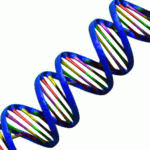Genetics
|
31 may 2012 14:07:31 |
| Efficiency of genomic selection using Bayesian multimarker models for traits selected to reflect a wide range of heritabilities and frequencies of detected quantitative traits loci in mice (BMC Genetics) |
|
Tweet Background:
Genomic selection uses dense single nucleotide polymorphisms (SNP) markers to predictbreeding values, as compared to conventional evaluations which estimate polygenic effectsbased on phenotypic records and pedigree information. The objective of this study was tocompare polygenic, genomic and combined polygenic-genomic models, including mixturemodels (labelled according to the percentage of genotyped SNP markers considered to have asubstantial effect, ranging from 2.5 % to 100 %). The data consisted of phenotypes and SNPgenotypes (10,946 SNPs) of 2,188 mice. Various growth, behavioural and physiological traitswere selected for the analysis to reflect a wide range of heritabilities (0.10 to 0.74) andnumbers of detected quantitative traits loci (QTL) (1 to 20) affecting those traits. The analysisincluded estimation of variance components and cross-validation within and betweenfamilies.
Results:
Genomic selection showed a high predictive ability (PA) in comparison to traditionalpolygenic selection, especially for traits of moderate heritability and when cross-validationwas between families. This occurred although the proportion of genomic variance of traitsusing genomic models was 22 to 33 % smaller than using polygenic models. Using a 2.5 %mixture genomic model, the proportion of genomic variance was 79 % smaller relative to thepolygenic model. Although the proportion of variance explained by the markers was reducedfurther when a smaller number of SNPs was assumed to have a substantial effect on the trait,PA of genomic selection for most traits was little affected. These low mixture percentagesresulted in improved estimates of single SNP effects. Genomic models implemented for traitswith fewer QTLs showed even lower PA than the polygenic models.
Conclusions:
Genomic selection generally performed better than traditional polygenic selection, especiallyin the context of between family cross-validation. Reducing the number of markersconsidered to affect the trait did not significantly change PA for most traits, particularly in thecase of within family cross-validation, but increased the number of markers found to beassociated with QTLs. The underlying number of QTLs affecting the trait has an effect onPA, with a smaller number of QTLs resulting in lower PA using the genomic modelcompared to the polygenic model. |
| 347 viewsCategory: Genetics |
 A Duplication CNV That Conveys Traits Reciprocal to Metabolic Syndrome and Protects against Diet-Induced Obesity in Mice and Men (PLoS Genetics) A Duplication CNV That Conveys Traits Reciprocal to Metabolic Syndrome and Protects against Diet-Induced Obesity in Mice and Men (PLoS Genetics)The App-Runx1 Region Is Critical for Birth Defects and Electrocardiographic Dysfunctions Observed in a Down Syndrome Mouse Model (PLoS Genetics) 
|
| blog comments powered by Disqus |
MyJournals.org
The latest issues of all your favorite science journals on one page
The latest issues of all your favorite science journals on one page



